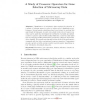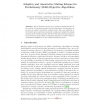AE
2007
Springer
14 years 5 months ago
2007
Springer
Abstract. We follow up on the work of Ebner[1] in studying representations for evolutionary design of objects. We adopt both the method and the simulation framework, and perform mo...
AE
2007
Springer
14 years 5 months ago
2007
Springer
We propose using the so called Royal Road functions as test functions for cooperative co-evolutionary algorithms (CCEAs). The Royal Road functions were created in the early 90’s ...
AE
2007
Springer
14 years 5 months ago
2007
Springer
A simple mechanism is presented for the emergence of recognition patterns that are used by individuals to find each other and mate. The genetic component determines the brain of an...
AE
2007
Springer
14 years 5 months ago
2007
Springer
Abstract. How has a stack of n blocks to be arranged in order to maximize its overhang over a table edge while being stable? This question can be seen as an example application for...
AE
2007
Springer
14 years 5 months ago
2007
Springer
Classification of microarray data requires the selection of a subset of relevant genes in order to achieve good classification performance. Several genetic algorithms have been d...
AE
2007
Springer
14 years 5 months ago
2007
Springer
AE
2007
Springer
14 years 5 months ago
2007
Springer
We are interested in the role of restricted mating schemes in the context of evolutionary multi-objective algorithms. In this paper, we propose an adaptive assortative mating schem...
ACAL
2007
Springer
14 years 5 months ago
2007
Springer
This paper presents in-formation flocking, a novel information visualization technique that extends the original information flocking concept with dynamic and data-driven visual fo...
ACAL
2007
Springer
14 years 5 months ago
2007
Springer
Abstract. Running droplets have been studied recent years as dissipative macroscopic structures with locomotive capability, a characteristic of which is shared with biological syst...
ACAL
2007
Springer
14 years 5 months ago
2007
Springer
Abstract. In this paper, we apply a theoretical swarm-generating technique to a system implementing cluster-based construction. The technique, known as swarm engineering consists o...


